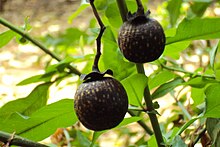Vitex doniana
| Vitex doniana | ||||||||||||
|---|---|---|---|---|---|---|---|---|---|---|---|---|
| Systematics | ||||||||||||
|
||||||||||||
| Scientific name | ||||||||||||
| Vitex doniana | ||||||||||||
| Sweet |
Vitex doniana is a tree in the mint family from West , Central and East Africa to southern Africa.
description
Vitex doniana grows as a deciduous tree up to 25 meters high. The trunk diameter can reach over 100 centimeters. The brownish to gray-brown bark is cracked to furrowed and flaky or scaly.
The simple and stalked leaves are opposite and assembled palmate with 3–7 leaflets . The petiole is up to 20 centimeters long. The short-stalked, entire, leathery and almost bald leaflets are up to 25 centimeters long and 10 centimeters wide. The leaflet stalks are up to 2.5 inches long. The leaflets are ovate to elliptical or obovate and at the tip they are rounded to indented or, less often, pointed.
Axillary and smaller, more or less rusty hairy, longer-stalked cymes are formed. The hermaphroditic and short-stalked, white to light violet, small purple flowers are five-fold with a double flower envelope . The cup-shaped calyx with small tips is up to 5 millimeters long and has rusty hair on the outside. The petals are in the typical shape of the mint family, they are fused in a tube up to 6–8 millimeters long with two-lipped lobes, the middle lobe of the lower lip is enlarged and yellowish hairy in the lower part, up to 4.5 millimeters long and longer like that another 4, to 3 millimeter long lobes. The 4 stamens are didynamic and slightly protruding. The four-chambered ovary is upper constant with a longer stylus .
It forms 2-3 centimeters large, round, multi-seeded and dark to black-purple, more or less beige dotted, smooth drupes with a permanent calyx. The woody stone core contains up to 4 seeds.
The number of chromosomes is 2n = 32.
use
The fruits are edible and are consumed raw, cooked or candied . An oil can be obtained from the seeds
The bark , roots and leaves as well as the fruits are used medicinally.
The medium-weight, soft and non-durable wood is used for some applications. It is known as African oak , Meru oak, or Vitex .
literature
- Food and fruit-bearing forest species. 1: Examples from Eastern Africa , FAO Forestry Paper 44/1, FAO 1983, ISBN 92-5-101385-3 , pp. 139-142, online (PDF; 8.3 MB).
- Jules Janick, Robert E. Paull. The Encyclopedia of Fruit and Nuts. CABI, 2008, ISBN 0-85199-638-8 , pp. 905 f.
- Martin Chudnoff: Tropical Timbers of the World. Agriculture Handbook 607, USDA Forest Service, 1984, p. 288, limited preview in Google Book Search.
Web links
- Vitex doniana at PROTA.
- Vitex doniana at Useful Tropical Plants.
- Vitex doniana . In: S. Dressler, M. Schmidt, G. Zizka (Eds.): African plants - A Photo Guide. Senckenberg, Frankfurt / Main 2014.
